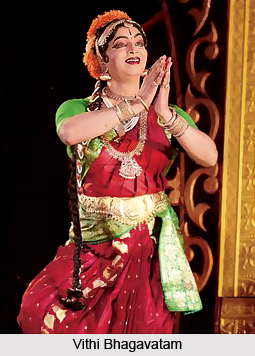 Vithi Bhagavatam is a conventional dance drama, and it is believed that Siddhendra Yogi banned the women from participating and it became an exclusive prerogative of the male dancers. Talented male dancers with histrionic skills impersonated female roles even surpassing the female artists and have won legendary fame. However, there are some exceptions to this very culture.
Vithi Bhagavatam is a conventional dance drama, and it is believed that Siddhendra Yogi banned the women from participating and it became an exclusive prerogative of the male dancers. Talented male dancers with histrionic skills impersonated female roles even surpassing the female artists and have won legendary fame. However, there are some exceptions to this very culture.Evolution of Vithi Bhagavatam
Towards the end of 19th century AD, a few art educated pundits in dance drama and Natya Shastra, migrated from Kuchipudi, crossed Godavari and settled down at Pithapuram, Amalapuram and Mandapeta. Some went to Chintalandi, Eluru or Chattapparu. The surnames of these pundits were changed later and known as Bharatamvaru. Most of them imparted training to female dancers and produced their versions of Kuchipudi dance drama repertoire. So a derivate solo dance performance came into being known as Vithi Bhagavatam.
The girl artists generally from the families of courtesan, expert in sadir nautch, solo dance forms, were trained by Bharatamvaru in their repertoire. By mixing these two forms, Vithi Bhagavatam evolved. Independent of Kuchipudi dancer and their groups, the female dancer made Vithi Bhagavatam famous. Instead of separate solo pieces, Bharatamvarus instructed the Kalavantulu, courtesans, into a sustained Bhagavata folklore.
Vithi Bhagavatam has two kalapams in its repertoire; i.e. Bhama Kalapam and Golla Kalapam. These special kalapams feature single female dancers. To put across the argument succinctly, sometimes a Brahmin joins in Golla Kalapam. He also provides the much needed commentary and humour, like vidushaka in Kudiyattam and acts as an interlocutor. Gola Kalapam in this very genre has many versions and more or less follows same arguments as seen in Kuchipudi dance drama version of Golla Kalapam.
For more, visit the link below: